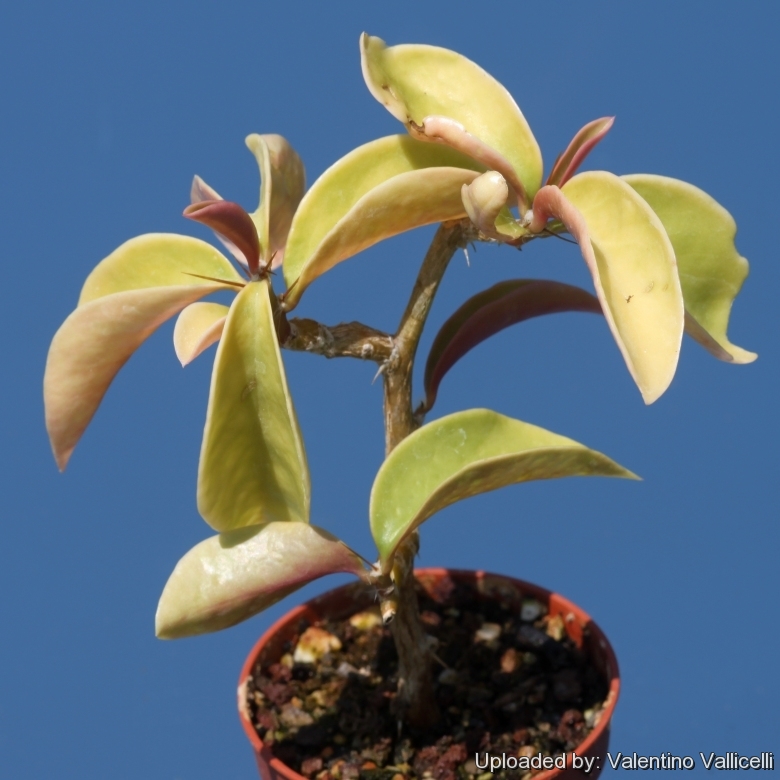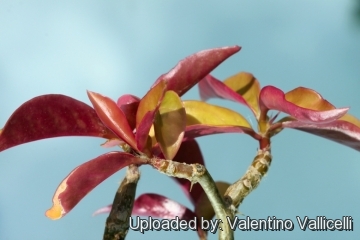= Pereskia aculeata cv. godseffiana
Accepted Scientific Name: Pereskia aculeata Mill.
Gard. Dict., ed. 8. s.p. 1768 Mill.

Pereskia godseffiana (Pereskia aculeata cv. godseffiana) Photo by: Valentino Vallicelli
Origin and Habitat: Garden origin. The natural species (Pereskia aculeataSN|27182]]SN|27182]]) is native to most parts of Tropical south and central America, Caribbean, Florida and Mexico.
Synonyms:
See all synonyms of Pereskia aculeata
back
Accepted name in llifle Database:Pereskia aculeata Mill.Gard. Dict., ed. 8. s.p. 1768Synonymy: 14
Cultivars
(1):
back
Common Names include:
ENGLISH: Lemon Vine, Yellow rose cactus
Description: Pereskia aculeataSN|27182]]SN|27182]] cv Godseffiana also known as "Lemon Vine" or "Yellow Rose Cactus" is a unique vining leafy cactus that is not succulent, it bears spines in pairs or trios. This plant may not look like a typical cactus but it in fact is. Leaves of green to goldish yellow with peach tones highlight the white fragrant rose-like flowers that are produced all summer. The fruit is yellow and spiny. It is evergreen but may be deciduous in the dry season.
Stems: At first erect and then vining to about 9 m long.
Leaves: Short-petioled, simple, entire, lanceolate to ovate, short-acuminate at the apex, tapering or rounded at base, about 4-10 cm long, 2-4 cm broad, salmon-yellow with the underneath side of the leaves a reddish purple. Typically, Pereskia aculeataSN|27182]]SN|27182]] var. godseffiana has a deciduous lifecycle, so it tends to shed its leaves annually in the dry season.
Areoles: There are 1-3 spines in each areole.
Spines: Short hooked in clusters of 2 or 3 in the axils of the leaves of younger stem. Spines on older, lower part of stem solitary or 2 or 3 together, slender, woody and straight occasionally up to 7 cm long.
Flowers: Numerous in panicles or corymbs, white, pale yellow, or pinkish, 2.5 to 5 cm broad strongly scented; ovary leafy and often spiny.
Blooming season: In the greenhouse, the plants bloom in late spring.
Fruit: A rounded berry, translucent white to light yellow, orange or red, 1.5 to 2 cm in diameter, when mature quite smooth. The fruit are also edible, containing numerous small seeds. It somewhat resembles the gooseberry in appearance and is of excellent flavour.
Seeds: Black, somewhat flattened, 4 to 5 mm in diameter; hilum basal, circular, depressed, or crater-shaped.
Subspecies, varieties, forms and cultivars of plants belonging to the Pereskia aculeata group
 Pereskia aculeata Mill.: has long, clambering stems and growing to 10 m tall. Has showy, fragrant blossoms, followed by beautiful clusters of yellow berries. Distribution: most parts of south and central America, Caribbean, Florida and Mexico.
Pereskia aculeata Mill.: has long, clambering stems and growing to 10 m tall. Has showy, fragrant blossoms, followed by beautiful clusters of yellow berries. Distribution: most parts of south and central America, Caribbean, Florida and Mexico. Pereskia aculeata cv. godseffiana: has salmon-yellow leaves with the underneath side a pinkish-purple.
Pereskia aculeata cv. godseffiana: has salmon-yellow leaves with the underneath side a pinkish-purple.
Bibliography: Major references and further lectures
1) Cal Lemke, Cal's Plant of the Week: “Pereskia aculeata cv 'Godseffiana' - Lemon Vine Cactaceae” University of Oklahoma Department of Microbiology & Plant Biology <http://www.plantoftheweek.org/week454.shtml> Web. 06 Aug. 2015.
2) Nathaniel Lord Britton, Joseph Nelson Rose “Cactaceae: Descriptions and Illustrations of Plants of the Cactus Family” vol. 1 The Carnegie Institution of Washington, Washington 1919 Edward Anderson “The Cactus family” Timber Press, Incorporated, 2001
3) James Cullen, Sabina G. Knees, H. Suzanne Cubey "The European Garden Flora Flowering Plants: A Manual for the Identification of Plants Cultivated in Europe, Both Out-of-Doors and Under Glass" Cambridge University Press, 11/Aug/2011
4) David R Hunt; Nigel P Taylor; Graham Charles; International Cactaceae Systematics Group. "The New Cactus Lexicon" dh books, 2006
5) "Grocer's Encyclopedia: The Encyclopedia of Food and Beverage", by Artemas Ward, New York, http://www.hear.org/Pier/wra/pacific/pereskia_aculeata_htmlwra.htm 1911
6) Wikipedia contributors. "Pereskia aculeata." Wikipedia, The Free Encyclopedia. Wikipedia, The Free Encyclopedia, 16 May. 2014. Web. 29 Jul. 2014
7) Morton, J.F. X ”Fruits of Warm Climates.” Julia Morton 20534 SW 92 Ct., Miami Fl. 1987
8) Peter Hanelt, Institute of Plant Genetics and Crop Plant Research, W. Kilian “Mansfeld's Encyclopedia of Agricultural and Horticultural Crops: (Except Ornamentals)” Springer Science & Business Media, 10/Apr/2001
 Pereskia godseffiana (Pereskia aculeata cv. godseffiana) Photo by: Valentino Vallicelli
Pereskia godseffiana (Pereskia aculeata cv. godseffiana) Photo by: Valentino VallicelliSend a photo of this plant.The gallery now contains thousands of pictures, however it is possible to do even more. We are, of course, seeking photos of species not yet shown in the gallery but not only that, we are also looking for better pictures than those already present.
Read More... Cultivation and Propagation: Nearly indestructible, Pereskia aculeata cv Godseffiana requires full sun or light shade (but withstand dense shade) and well drained soils, preferably rich neutral organic soils, but may tolerate acidic ones and is suited for tropical or subtropical climates but may survive very light frosts (if very short). It is suitable for growing in hanging baskets where it can't get away and can be pruned to a desireable size. The plant survives from even the smallest of cuttings.
Growing rate: The golden form is very ornamental and unusual but slow growing compared to the weedy nature of the variegated and green forms. With selective pruning and container size the growth of the plants can be controlled so they don’t get out of hand.
Soil: In the greenhouse, we use a soil mix consisting of 2 parts peat moss to 1 part loam to 2 parts coarse sand.
Fertilization: Fertilize them monthly with a balanced fertilizer during the growing season.
Exposure: The plant can be placed in full sunlight and does not need any protection in the summer, not even when placed on a window sill facing South. Full sunlight is necessary if the leaves turn to a fine bronze colour. If the plant is placed in too dark a place, the leaves will become green.
Waterings: Water regularly during the active growing season from March to September. No water should ever be allowed to stand around the roots. Keep almost completely dry in winter. It is drought resistant, but leaves drop during drought. A humid atmosphere is essential and frequent spraying with tepid water is most beneficial. Watch for winter rains that can cause rot also.
Hardiness: Considered frost tender, but surprisingly cold hardy outdoors and also very sun hardy for a succulent plant. It likes warmth (recommended minimum winter temperature 10° C) however plants kept perfectly dry can can survive low temperatures, approx. to -3°C., but for safe cultivation it is best to avoid freezing temperatures. Never let the roots chill. Deciduous below 4°C. They are very easy to grow and are hardy in the landscape in USDA zones 9-11.
Maintenance: Can be pruned for shape and branching.
Plant Pests: Prone to mealy bugs and rarely scale.
Uses: Often used for edges it is planted by pushing cutting into the ground, its spiny stem soon forming a capital barrier, sometimes grown as a climber, as a basket plant, or in the form
of a pyramid. The leaves and fruits are edible, containing high quantities of protein (20 to 30% of protein in the dry leaf matter), iron and other nutrients, and it is a popular vegetable in parts of the Brazilian state of Minas Gerais under the name of ora-pro-nóbis. The leaves are used in green salads, or can be cooked. In rural Brazil, the leaves, stems and fruits are also used for food for animals. All varieties of Pereskia aculeataSN|27182]]SN|27182]] can be eaten raw even the golden form. The variegated and the green form are better producers of vegetable.
Grafting: The thin stems are often used as stock on which to graft Zygocactus and other epiphytic cacti, where they grow away more successfully than when grown in the normal way from a cutting.
Propagation: It's very easy to propagate from cuttings, contrarily to most other cacti, Pereskia cuttings should be planted immediately without a dry out period. (you can also let them sit in a jar of water). Use young shoots approximately 7 cm long, which will root quite easily when placed in a small pot with sandy soil. The cuttings will start to root in only four days in a glass of water. If older plants develop long straggly shoots, these may be pruned back during early spring. This is also the time for repotting. Use good potting compost.












